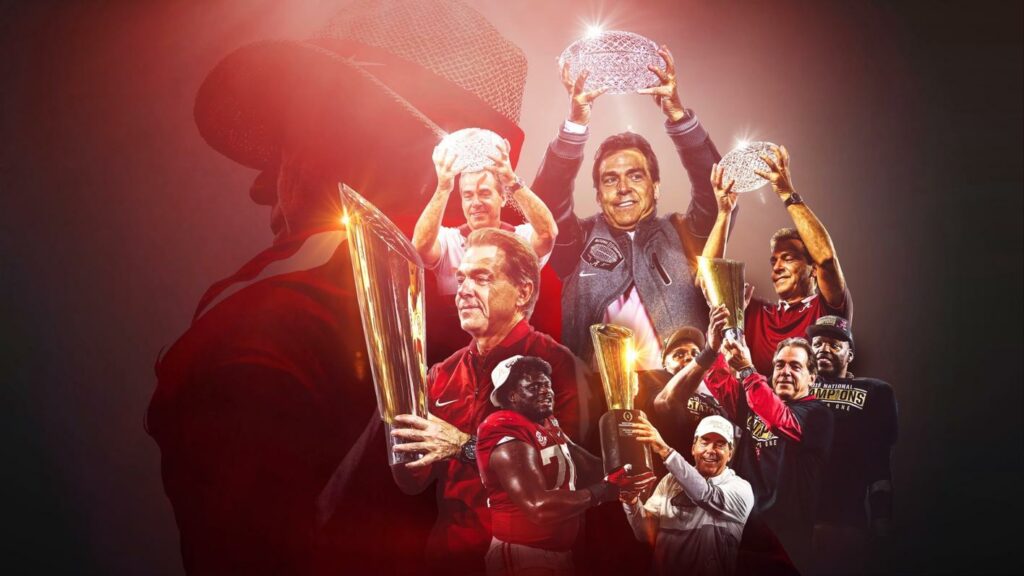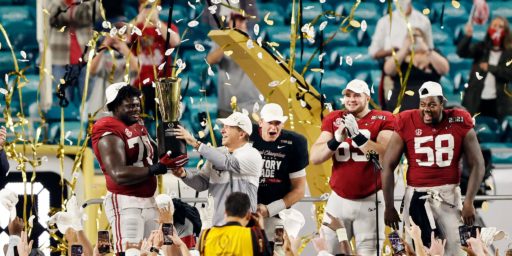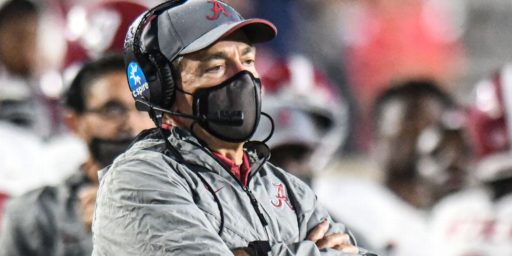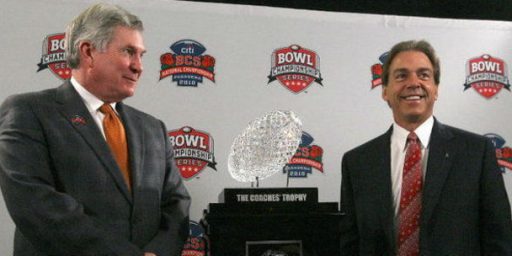Nick Saban Retires
The greatest coach in college football history is hanging it up.

Alabama’s Nick Saban, who has won more college football national championships than any coach in the modern era, announced his retirement on Wednesday.
“The University of Alabama has been a very special place to Terry and me,” Saban said. “We have enjoyed every minute of our 17 years being the head coach at Alabama as well as becoming a part of the Tuscaloosa community. It is not just about how many games we won and lost, but it’s about the legacy and how we went about it. We always tried to do it the right way. The goal was always to help players create more value for their future, be the best player they could be and be more successful in life because they were part of the program. Hopefully, we have done that, and we will always consider Alabama our home.”
Saban spent 28 years as a college head coach at Toledo (1990), Michigan State (1995-99), LSU (2000-04) and Alabama (2007-23). He won seven national titles in those 28 years, his first at LSU in 2003 before capturing six championships at Alabama (2009, 2011-12, 2015, 2017 and 2020). He also coached the Miami Dolphins for two seasons (2005-06).
“Simply put, Nick Saban is one of the greatest coaches of all time, in any sport, and The University of Alabama is fortunate to have had him leading our football program for the past 17 seasons,” said Alabama Director of Athletics Greg Byrne. “Throughout his career as a head coach, his teams have won seven national championships, 11 conference championships and 312 games, and he’s developed an NCAA-record 49 NFL first-round draft picks and, most importantly, hundreds of college graduates. He is the consummate coach, mentor and leader, and his impact is felt far beyond the football field.
“Coach Saban and Ms. Terry have touched countless lives in our community and the state of Alabama with the work they’ve done through the Nick’s Kids Foundation. While his time as our coach may have come to an end, his legacy will live on forever. What an honor it has been for us to have a front-row seat to one of the best to ever do it. A truly remarkable career for Coach Saban.”
Saban’s teams won three national championships during the Bowl Championship Series era and three more after the start of the College Football Playoff. In 10 seasons of the CFP, Saban’s Crimson Tide teams qualified eight times.
“Words cannot adequately express our appreciation to Coach Saban for his exemplary leadership and service to The University of Alabama over the past 17 years,” said Alabama President Stuart R. Bell. “His commitment to excellence has set the standard for our program, both on the field and in the classroom. We are grateful for the lasting impact he has made on the lives of our student-athletes and the incredible memories his teams have created for our students, alumni, fans and supporters.
“Coach Saban and Ms. Terry are tremendous ambassadors for The University of Alabama and our community and we celebrate their many contributions and indelible legacy.”
Saban compiled a 297-71-1 (.806) collegiate coaching record, including a 206-29 (.877) mark in Tuscaloosa. His teams won a combined 11 SEC titles, going 11-1 in SEC Championship Games, including nine at Alabama (9-1 record) and two at LSU (2-0 mark). He also won 15 games with the Dolphins in 2005-06.
In Saban’s six national championship seasons at Alabama, his teams went 21-2 against top-10 opponents, and, since 2008, the Crimson Tide was 37-15 overall against top-10 teams. Alabama was also ranked No. 1 in the Associated Press Poll for at least one week for 15 straight years (2008-22), which broke the record of seven established by Miami (1986-92).
Saban coached four Heisman Trophy winners, joining Notre Dame’s Frank Leahy for the most in college football history. He is the only coach to ever coach Heisman Trophy winners at three different positions (RB, WR, QB). The Alabama program had just six individual national award winners when Saban arrived on campus, but Crimson Tide players have secured 60 national awards since 2008.
His players at Alabama have won 66 All-America honors by 58 different individuals over the past 16 seasons. Eight players have been named two-time All-Americans along with 46 consensus honors and 25 unanimous selections. Will Anderson Jr. became the first two-time unanimous All-American in Alabama history.
Saban’s success has also translated to NFL success for his players with a record 49 players chosen in the first round of the draft (44 at Alabama). His Alabama players have been paid over $2 billion over the last 16 NFL seasons.
Alabama’s success on the field over the past 17 seasons has coincided with the Tide’s success in the classroom. Since Saban’s arrival in 2007, Alabama football has seen a total of 656 degrees earned, including 103 master’s degrees.
The Sabans Nick’s Kids Foundation is a vibrant example of the family’s continuing concern for disadvantaged children. Since Nick and Terry arrived in Tuscaloosa, over $12 million has been distributed to students, teachers and children’s causes at over 150 charities through the Nick’s Kids Foundation.
As an Alabama alumnus and fan, I’ve written about Saban many times over the years including my wildly incorrect prediction after Mike Shula was fired that “There’s no way on earth Saban would be interested.” I redeemed myself with a January 2007 column for the now-defunct TCS Daily titled “Crimson with Envy: Why Nick Saban Makes More Than Your Kid’s Teacher.”
If Saban is able to return the Crimson Tide to its former glory, he’ll more than pay for himself. Between July 1, 2005, and June 30, 2006, the football team alone brought in more than $44 million. Indeed, football at successful programs like Alabama’s not only pays for itself, it helps pay for all the other sports programs on campus and pours millions into the school’s academic scholarship funds.
That turned out to not only be prescient but to undersell what Saban would accomplish. His achievements on the football field, which I’ll get to shortly, exceeded even the most unreasonable expectations Alabama fans are known for. But, while Saban is hardly the only reason, he has been a large factor in the university nearly doubling its enrollment while significantly increasing its admissions standards and climbing the academic rankings.
As to Saban’s accomplishments as a coach, ESPN’s Ryan McGee speaks for most observers:
Nick Saban is the best who has ever done it.
There is no argument to be made against that. None. It is a statement of fact. Any historian who says otherwise is one of those folks who spends their days surrounded by dust-covered books about the single wing, watching black-and-white films on their pocket computers, the ones who so desperately hang on to that overcooked idea that things were always better way back when. Any current observer of college football who pushes back on that point is likely a bitter fan of a team Saban’s squads regularly drubbed, or one the players or coaches who were on the rosters of those teams, denied greatness by greatness.
He’s the best. Period. And now there is a period at the end of his unparalleled career. On Wednesday afternoon, ESPN’s Chris Low broke the news that after 17 seasons as the head coach of the Alabama Crimson Tide, Saban is hanging up his headset.
Over those 17 seasons, he won a half-dozen national titles, 201 games, and 11 SEC championships during the most competitive era of any conference in the 154-year history of college football. He had a team ranked No. 1 at least once during all but two of those seasons.
Statistics like that make no sense. They don’t look real. The math looks like it cheated, and yet it all adds up to the greatest college football résumé ever written. That point is inarguable.
Bear Bryant, he who built Bama and previously held GOAT status in most minds, also won six national championships in Tuscaloosa, thanks to a willingness — after an admitted initial reluctance — to evolve, modernizing his offensive mind. At Notre Dame, Knute Rockne revolutionized the way a true college football program is constructed and steered. Frank Leahy saved what Rockne had built, revitalizing a struggling program and returning it to its former glory. At Florida State, Bobby Bowden forever changed the way rosters are recruited and assembled. Pop Warner championed safety innovations and managed to balance a hefty ego by continually campaigning to keep football healthy at its grassroots. Woody Hayes had a temper that was only slightly less combustible than a barrelful of gunpowder, but he won big games and planted a coaching tree with more branches than one could possibly keep track of.
Nick Saban did all of the above. Not only that, but he also did it all better. And while he has filled college football with his proteges — Kirby Smart, Steve Sarkisian, Lane Kiffin and Dan Lanning, to name just a few — he has also done all of the above for so long that we have forgotten exactly how long. As good as he has always looked in Crimson, he also looked pretty spiffy in Toledo blue and gold, Michigan State green and white, and LSU purple and gold. His first head coaching job was at Toledo in 1990. In the nearly 30 seasons spent on a sideline since, he never had a losing season.
At LSU and Alabama, it is tempting to slash a historical line between his arrival and everything prior. Let’s call it “Before Saban” and “After Saban” but not use the acronyms. Why? Because anyone who has ever talked with the coach knows there is no BS about him.
Before Saban, LSU hadn’t won a national title since 1958. In 2003, he fixed that. After Saban, the Tigers have added two more.
Before Saban, Bama hadn’t won a national title since 1992 and only one since Bryant’s sixth in 1979. After Saban, it has won six.
Before Saban, no Tide player had ever won a Heisman Trophy. After Saban, they’ve brought home four stiff-armed awards.
The list goes on and on. But perhaps the most telling and impactful dividing line is less BS/AS and more OS/NS, as in “Old Saban” and “New Saban.” Football-wise, that’s about his Bryant-like willingness to change his offensive philosophy. As the game increasingly sped up and spread out, he openly campaigned for rules that would keep offensive football slower and closer to his longtime pro-set, run-first beliefs. When he realized that was a losing battle, he not only embraced up-tempo offenses, he accelerated their development. He hired West Coasters like Kiffin and Sarkisian. Against all odds, Alabama became the new Wide Receiver U.
While “greatest of all time” is naturally subject to intense debate, Saban is the overwhelming consensus choice for the title. McGee mentions the obvious contenders but Paul “Bear” Bryant, another legendary Alabama coach, was probably the most-mentioned choice before Saban surpassed him with a 7th national title three years ago.
It’s a much tougher task these days than in Bear’s day. Bryant could offer essentially unlimited scholarships. And, once a player committed to a school, they were stuck. Saban has managed to dominate recruiting despite rules changes designed to make it nearly impossible to do.
More importantly, all of Saban’s titles have come in the BCS and Playoff era. Rather than simply playing a postseason bowl game and having sports writers vote on a champion, the BCS matched the #1 and #2 ranked teams in a bowl game. Four of Saban’s titles—at LSU in 2003* and at Alabama in 2009, 2011, and 2012—came under that system. The last three—2015, 2017, and 2020 (all at Alabama)—came in the era of a playoff pitting the #1 team against the #4 team, the #2 team against the #3 team, and then a second round with the winners of those games facing each other. Three additional times—2016, 2018, and 2021—Saban’s teams made it to the championship game and lost. That’s just a brutal gauntlet.
Saban is 72, so it has been natural to speculate about his retirement the last few years. He has always said that he would do it as long as he was enjoying it and believed he could give it his all. By all indications, he was enjoying himself more than ever in recent years. But I guess he’s finally decided that he should spend his golden years with his wife, kids, and grandchildren rather than grinding 16 hours a day to win football games.
The last Alabama legend to retire, Bryant, retired after beating Illinois in the Liberty Bowl on December 29, 1982. He died inside a month. But Bear had been quite ill, living a famously unhealthy lifestyle. Aside from his morning ritual of two Little Debbie Oatmeal Creme Pies, Saban is something of a health nut, famously having the same turkey salad with iceberg lettuce for lunch every day. Until his hip surgery in 2019, he was still playing a daily game of basketball with his coaching staff.
Here’s wishing the GOAT a long and happy retirement. He has left some mighty big shoes to fill.
_____________
*I follow the custom of awarding the titles based on the year the regular season was played, even though the championship games are in the following January.






ESPN is quoting “sources” that say Saban was increasingly frustrated with the NIL and the portal. And not looking forward to the expanded playoff.
I’m told by my many friends in and around college basketball that teenagers are less coachable than ever. How much of that is real and how much is general “kids these day” hoo-ha, I don’t know. But. May be a factor, if same is true in college football.
@DK: I think that’s right. I don’t think he minds true NIL—players cashing in on their fame—but, like many, he’s opposed to the Pay For Play mindset, especially combined with unfettered free agency. His whole mindset has been about relationship-building and player development. You can’t do that if the kids bolt after a year or two because they’re not getting enough playing time and/or they’re getting offered more money to play somewhere else.
Speaking as someone who grew up in Tuscaloosa, moved away in 1999, and comes back to visit family, the Saban worship in Tuscaloosa/at the University of Alabama is just creepy.
Ryan McGee of ESPN seems to have forgotten Joe Paterno. The Sandusky business was disgusting but Paterno’s history of success on the field has been rarely matched.
1968 to 1977, PS had five seasons of either 1 or 0 losses, but the Nittany Lions rarely ranked wells. They were an eastern team and given little respect.
In 1978 they went undefeated and played the #2* in the nation in the Sugar Bowl. One of the few 1-2 matchups prior to 2000. PS lost 14-7 but not long after that Paterno and Lions started getting some respect from people
McGee’s blunder reminds me of Doug Ferguson, AP’s golf writer, when listing greatest shots in Masters history forgetting to name Larry Mize’s chip-in at the 1987 tournament. He was only 40 yards away from the hole but seems insignificant compared to Jack Nicklaus making a 10-footer on the 17th hole one year earlier to Ferguson. Say what?
*- I’ll let James fill in who the #2 team was. I rarely watch CF anymore, but I did watch that game and the goal line stand by the #2 team that prevented PS from coming out on top.
@Kevin:
As one of his young teenaged female fans said, “Saban is God.”
Saban was head coach of the Miami Dolphins before Alabama. He took the BAMA even before Miami’s 2006 season was over.
Many Dolphins fans hate Saban. What was my view- Meh. Saban wasn’t suited for pro ball. The worst thing he was involved in while at Miami was deciding to sign Daunte Culpepper instead of Drew Brees to play QB. Saban, since 2021, has tried to spin that decision as being counter to what he wanted to do but news reports 2017 and earlier say otherwise. Culpepper played 4 games for Miami, Brees spent 15 seasons in SD.
@Bill Jempty: Leaving aside the Sandusky scandal, Paterno had a hell of a career, amassing an insane number of wins. But he only won two national titles (1982 and 1986) to Saban’s seven. He’s not even in the conversation.
@Bill Jempty: Saban wanted Brees, even personally recruiting him. That’s been the story since at least 2006.
@James Joyner:
James,
McGee mentions Bowden, two titles and Hayes who had three but over 150 less career victories. To mention those two and leave out Paterno is moronic.
@Bill Jempty: Ah. McGee mentions the others for revolutionizing some aspect of the game to draw the comparison with Saban. Aside from sustained excellence over an incredibly long period of time, I’m not sure Paterno did that.